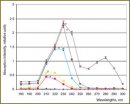
The Effect of Gas-Discharge Plasma Radiation on Erythrocyte Protein Modification
The aim of the investigation was to estimate the effect of spark plasma radiation on oxidative protein modification in solutions and erythrocytes in experiments and in vitro.
Materials and Methods. Pulse spark discharge generating low-temperature plasma radiation was formed using an experimental device PILIMIN series IR-10 (Russia). The characteristics of a discharge were the following: capacity of pulse capacitor — 3.3 nF, ballast resistance — 10 MΩ, power supply voltage — 11 kV, pulse recurrence frequency — 10 Hz. Tryptophan, albumin, hemoglobin solutions, and erythrocyte suspensions of intact animals and animals with experimental sarcoma were used as research subjects. 4 ml samples were treated in sterile Petri plates. Structural state of tryptophan, albumin and hemoglobin molecules was assessed by UV absorption spectra. Oxidative protein damage degree in solutions and cells was estimated by bityrosine and tryptophan fluorescence.
Results. The increase of oxidative protein modification in solutions after spark discharge plasma radiation is due to the presence of complexes of tryptophan, albumin and hemoglobin molecules with nitro compounds, nitric radicals, hydroperoxyl radicals formed under discharge generation. Erythrocyte protein structures of animals with experimental sarcoma are characterized by more intense oxidative modification compared to erythrocytes of intact animals. Oxidative modification of erythrocyte proteins under plasma radiation to greater degree is due to the accumulation of bityrosine cross-links.
- Ivanova I.P., Trofimova S.V., Karpel Vel Leitner N., Аristova N.А., Arkhipova Е.V., Burkhina О.Е., Sysoeva V.А., Piskaryov I.M. The analysis of active products of spark discharge plasma radiation determining biological effects in tissues. Sovremennye tehnologii v medicine 2012; 2: 20–30.
- Ivanova I.P., Trofimova S.V., Piskaryov I.M. The influence of the spark discharge plasma radiation on protein’s and lipid’s modification. Fundamentalnie issledovania 2013; 1(3): 572–575.
- Ivanova I.P., Trofimova S.V., Piskaryov I.M., Burkhina О.Е., Sysoeva V.А., Karpel Vel Leitner N. The study of biocidal mechanisms of spark discharge plasma radiation. Sovremennye tehnologii v medicine 2012; 3: 12–18.
- Ivanova I.P., Trofimova S.V., Vedunova М.V., Zhabereva А.S., Bugrova M.L., Piskaryov I.M., Karpel Vel Leitner N. Assessment of cytotoxic effect mechanisms of gas-discharge plasma radiation. Sovremennye tehnologii v medicine 2014; 6(1): 14–22.
- Dubinina E.E., Gavrovskaya S.V., Kuz’mich E.V., Leonova N.V., Morozova M.G., Kovrugina S.V., Smirnova T.A. Oxidative protein modification: tryptophan oxidation and bityrosine formation in purified proteins using Fenton system. Biokhimiya 2002; 67: 413–421.
- Hixon J., Reshetnyak Y.K. Algorithm for the analysis of tryptophan fluorescence spectra and their correlation with protein structural parameters. Algorithms 2009; 2: 1155–1176, http://dx.doi.org/10.3390/a2031155.
- Pentin Yu.A., Kuramshina G.M. Osnovy molekulyarnoy spektroskopii [Basics of molecular spectroscopy]. Moscow: Mir; 2008; 398 p.
- Nikitina L.E., Plemenkov V.V. Fizicheskie metody identifikatsii organicheskikh soedineniy [Physical methods of identification of organic compounds]. Kazan 2003; 92 p.
- Mel’nikov M.Ya. Photochemistry of peroxide radicals in solid phase and on an activated surface of solid bodies. Vestnik Moskovskogo universiteta. Khimiya 2001; 42(3): 188–193.
- Piskaryov I.M., Ivanova I.P., Trofimova S.V., Aristova N.A. Formation of active particles in spark discharge and their possible application. Khimiya vysokikh energiy 2012; 46(5): 406–411.
- El’yashevich M.A. Atomnaya i molekulyarnaya spektroskopiya [Atomic and molecular spectroscopy]. Moscow: Editorial URSS; 2001; 896 p.
- Anisimova N.A. Identifikatsiya organicheskikh soedineniy [The identification of organic compounds]. Gorno-Altaysk: RIO GAGU; 2009; 95 p.
- Quinlan G.J., Martin G.S., Evans T.W. Albumin: biochemical properties and therapeutic potential. Hepatology 2005; 41(6): 1211–1219.
- Kazakova V.V., Elkina N.M. Oxidative modifications of the changes of intramolecular hydrophobic property of hemoglobin A in human erythrocyte incubation in Fenton medium. Ukraїns’kiy bіokhіmіchniy zhurnal 2007; 79(4): 34–38.
- Karnaukhova L.I., Tupitsyn E.N. UF-spektroskopiya biologicheskikh makromolekul [UV spectroscopy of biological macromolecules]. Saratov: SGU; 2002.
- Vyaz'min S.Yu., Ryabukhin D.S., Vasil'ev A.V. Elektronnaya spektroskopiya organicheskikh soedineniy [Electronic spectroscopy of organic compounds]. Saint Petersburg: SPbGLTA; 2011.
- Kroemer G., Pouyssegur J. Tumor cell metabolism: cancer’s Achilles’ heel. Cancer Cell 2008 Jun; 13(6): 472–482, http://dx.doi.org/10.1016/j.ccr.2008.05.005.
- Dubinina E.E. Produkty metabolizma kisloroda v funktsional’noy aktivnosti kletok (zhizn’ i smert’, sozidanie i razrushenie). Fiziologicheskie i kliniko-biokhimicheskie aspekty [Oxygen metabolism products in cell functional activity (life and death, creativeness and destruction). Physiological, clinical and biochemical aspects]. Saint Petersburg: Meditsinskaya pressa; 2006; 400 p.
- Gubskiy Yu.I., Belenichev I.F., Pavlov S.V. Toxicological sequences of oxidative protein modification in various pathological conditions (Review). Sovremennye problemy toksikologii 2005; 3: 20–26.
- Men’shchikova E.B. Okislitel’nyy stress: patologicheskie sostoyaniya i zabolevaniya [Oxidative stress: pathological conditions and diseases]. Novosibirsk: ARTA; 2008; 284 p.
- Abalenikhina Y.V., Fomina M.A., Churilov G.I., Ivanycheva Y.N. Oxidative protein modification rats thymus under the influence of copper in ultrafine form. Fundamentalnie issledovania 2012; 11(6): 1315–1319.
- DiMarco T., Giulivi C. Current analytical methods for the detection of dityrosine, a biomarker of oxidative stress, in biological samples. Mass Spectrom Rev 2007; 26(1): 108–120, http://dx.doi.org/10.1002/mas.20109.
- Muravleva L.Ye., Molotov-Luchansky V.B., Klyuyev D.A., et al. Oxidative protein modification: problems and research prospects. Fundamentalnie issledovania 2010; 1: 74–78.










